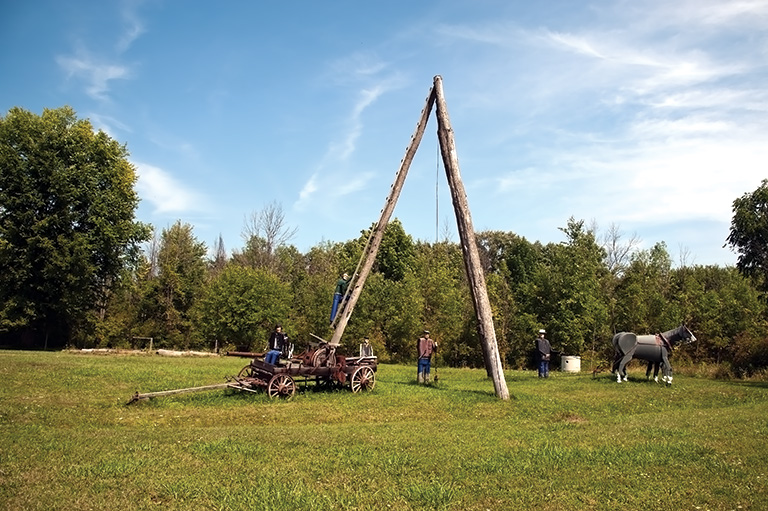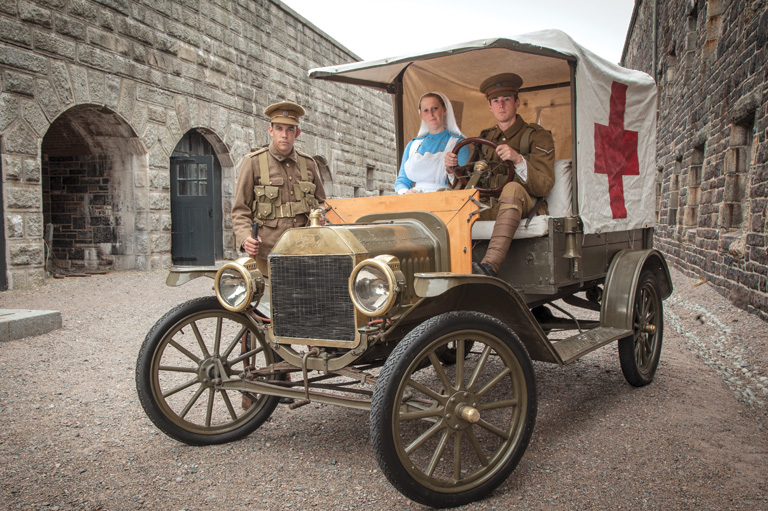Prairie Icons
Joseph Martsinkiw was an energetic man of many talents. He was a farmer, harvest-gang boss, telephone lineman, and carpenter. He built his own house and barn and the barns of neighbours. More than half a century on, the barns are abandoned. But you can still seem them around Donwell, the hamlet in east central Saskatchewan where he farmed, and they still stand straight and true.
Martsinkiw, our maternal grandfather, also built the cross that marks the grave where his teenage son was buried, and many more for other people in the district. His crosses and those fashioned by other Ukrainian-Canadians are found in countless rural cemeteries across the Prairies, some neatly tended and still in use, others all but forgotten or lost.
The burial grounds and little churches next to them are testaments to the faith of the settlers and their devotion to the ancient traditions they carried with them from eastern Europe. But as the parishes of an older farming generation pass away, so does the heritage they bestowed on Canada.
Some rural parishes remain healthy, if diminished, and their churches are restored and are kept in good shape by the members. But many more are going or gone. In the estimation of Ottawa-based ethnologist and historian Jennie Dutchak, this is “a tremendous loss, a chapter of Canadian history wiped out.”
For Dutchak, the loss is personal. Her mother was on the parish executive for the small church where she was baptized near Buchanan, Saskatchewan, and she recalls seeing her father carrying the protocol books, one of which dated to the beginnings of the church in 1910. That memory led her to thirty years of writing and publishing on the subject of Ukrainian Prairie churches.
As the nineteenth century drew to a close, thousands of immigrants poured into Western Canada following, and sometimes preceding, the railways that were being laid down at a furious pace to receive them. By the time the First World War stemmed the tide, more than a hundred thousand eastern Europeans had created a band of settlement that stretched from southeastern Manitoba to northwestern Alberta. They were mostly Galicians, Bukovinians, and Austro-Hungarians, names that designated where they came from. For most of them, their common language was Ukrainian, and this came to define them as an ethnicity before there was a state called Ukraine.
The settlers were devout followers of both the Orthodox and Greek Catholic (later called Ukrainian Catholic) faith, but at first few priests followed them. That didn’t stop the farmers from building churches, hoping perhaps to snag a priest from Winnipeg or to get a nearby Roman Catholic cleric to drop by to tend their spiritual needs.
The early arrivals were often illiterate. It meant that biblical teachings and even pre-Christian beliefs were transmitted orally and pictorially from generation to generation. The settlers relied on collective memory to raise churches and design their crosses, both those that adorned the cupolas and those in the cemeteries. The result was an exuberant and idiosyncratic outpouring of architectural and artistic forms drawn from distant Byzantine and Slavic traditions.
Consider a concrete cross found in the Holy Spirit Ukrainian cemetery near Rosthern, Saskatchewan, north of Saskatoon. The illustration of stalks of wheat found on one side of the marker recalls the parable of the sower, in which Christ teaches that seed falling on good soil brings a bountiful return. From pagan times wheat has been a powerful symbol of renewal in Slavic culture, and with Christianity it provided a religious lesson: The departed, planted in the rich soil of faith, attain resurrection. But for farmers it must surely also have expressed their yearning for abundant harvests in the harsh new land.
The flowers on the other side of the cross are probably poppies. The poppy traditionally symbolizes the great sleep of the grave before it is opened at the Second Coming. The stalk of wheat and the poppy are a frequent pairing, and both are often seen on Ukrainian Easter eggs.
Lower down on the Rosthern cross is a skull and crossbones. Rarely found on grave markers, the skull represents Golgotha, the place of Jesus’s crucifixion. Golgotha in translation means “the place of the skull.” The marker also includes, in Cyrillic lettering, the “IC XC” acronym for Jesus Christ, words meaning “eternal memory,” and information about the deceased.
A frequent image on Ukrainian cemetery crosses is what appears to be a star enclosed in a circle. It’s actually the sun in the spring — the beginning of new life and another symbol of resurrection. Sometimes you see what looks like a potted plant on grave markers. It is the tree of life.
The three-bar cross is associated with the Orthodox Church and its Slavic followers, who include Ukrainians, Russians, Serbs, and Bulgarians. The top bar, usually smaller than the others, represents the slat of wood above Jesus’s head, on which was written words meaning “Jesus of Nazareth, King of the Jews,” in three languages. The lowest bar, usually slanted, represents the piece of wood to which Christ’s feet were nailed. It is slanted because of the torturous nature of death by crucifixion. In the settler era, the three-bar cross appeared at both Ukrainian Catholic and Orthodox churches, but over time Catholic churches have adopted the Roman cross.
Yet another symbol bears a temporal message. On some grave markers, and especially on church-top crosses, the bars of the cross are placed above a crescent moon. This is said to represent the triumph of Christianity over Islam and dates from the sixteenth and seventeenth centuries, when Christian Slavs frequently clashed with Muslim Tatars and Turks.
Crosses were initially made of wood, but farmers quickly turned to more durable materials such as concrete and iron. Concrete, poured into moulds, was the easiest to work with. And so it’s not just Joe Martsinkiw’s barns, but also his crosses — thanks to his moulds — that are seen in the Donwell area, even after some of the churches next to which they stood have disappeared.
Such was the fate of Holy Trinity Orthodox Church of America near Hampton, Saskatchewan, built in 1909 and razed a few years ago. Only the cemetery remains, and it contains the crosses Martsinkiw built for Prokop and Anna Nikota, his wife’s parents. When we last visited several years ago, farmers still cut the grass leading to the cemetery, but the graveyard itself had become overgrown.
Even before the present era, many cemeteries were lost in fields and woods for various reasons, perhaps because a burial ground was created with the hope of adding a church that was never built. This happened with our paternal grandfather’s grave, which lies with about a dozen others in a copse bordering a farmer’s field near Amsterdam, Saskatchewan.
Jennie Dutchak laments the passing of the settler era: “First it was the schools, then it was the grain elevators, and now the churches, the icons of the Prairies. They’re going the way of the dinosaurs. Soon we’ll only see their pictures in museums.”
For Father Ihor Okhrimtchouk, the former chair of the rural issues committee of the Ukrainian Orthodox Church of Canada, the future is not so gloomy. Like Dutchak he is in Ottawa; but also like her his heart is in the Prairies. He sees the chance for a revival of rural parishes by winning new converts.
“We must reach beyond the Ukrainian community to other groups — Natives, people in mixed marriages, non-Ukrainians,” he says. “We should not neglect our beautiful traditions, but we must adjust the tools of the church.”
Themes associated with this article
Advertisement
Help support history teachers across Canada!
By donating your unused Aeroplan points to Canada’s History Society, you help us provide teachers with crucial resources by offsetting the cost of running our education and awards programs.




